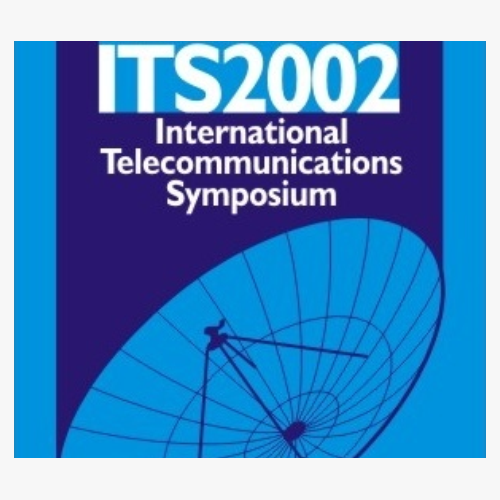
2002 International Telecommunications Symposium
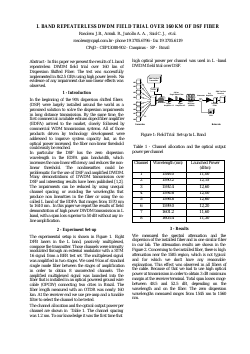
L Band Repeaterless DWDM Field Trial Over 160 KM of DSF Fiber
J. B. Rosolem, R. Arradi, A. A. Juriollo, C. J. Said
DOI: 10.14209/its.2002.774
Keywords:
Abstract
"In this paper we present the results of L band repeaterless DWDM field trial over 160 km of Dispersion Shifted Fiber. The test was successfully implemented in 8x2.5 GB/s using high power levels. No evidence of any impairment due non-linear effects was observed."Download
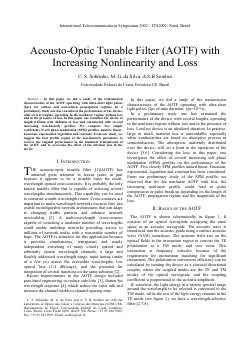
Acousto-Optic Tunable Filter (AOTF) with Increasing Nonlinearity and Loss
C. S. Sobrinho, M. G. da Silva, A. S. B. Sombra
DOI: 10.14209/its.2002.776
Keywords:
Abstract
"In this paper we did a study of the transmission characteristics of the AOTF operating with ultra-short light pulses (2ps), for soliton and non-soliton propagation regimes. In a preliminary study one has considered the performance of the device, with several lengths, operating in the nonlinear regime without loss and in the presence of loss. In this paper one considers the device of length 0.25mm with 4dB/mm of loss and constructed with several increasing non-linearity profiles. We compare five simple coefficients of self phase modulation (SPM) profiles, namely: linear, Gaussian, exponential, logarithm and constant. From our study, we suggest the best profile region of the non-linearity parameter to recover the original performance in the nonlinear transmission of the AOTF and to overcome the effect of the intrinsic loss in the device."Download
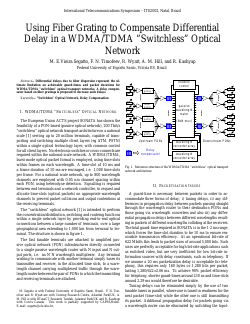
Using Fiber Grating to Compensate Differential Delay in a WDMA/TDMA "Switchless" Optical Systems
M. E.Vieira Segatto, F. N. Timofeev, R. Wyatt, A. M. Hill, R. Kashyap
DOI: 10.14209/its.2002.780
Keywords: Switchless Optical Network Delay Compensation
Abstract
"Differential delays due to fiber dispersion represent the ultimate limitation on achievable guard-times and packet durations for WDMA/TDMA ”switchless” optical transport networks. A delay compensator based on fiber gratings is proposed to decrease such delays"Download

Using Asynchronous Histograms for Characterizing and Evaluating Optical Systems
António L. J. Teixeira, Paulo S. B. André, Mário J. N. Lima, José F. Da Rocha, J. Lemos Pinto
DOI: 10.14209/its.2002.786
Keywords:
Abstract
"In this paper we will show the application of the asynchronous histograms for monitoring and characterizing, at low sampling rate, very high data rate systems. We will describe the method and its results for two transition functions, which correspond to two different pulse shapes. From the results we show the possibility of obtaining an amplitude description of the eye diagram from one completely closed eye observed by asynchronous, under-sampled eye diagram and/or amplitude histograms."Download

All-optical deflection induced by cross-phase modulation in solutions of beta-carotene with CW lasers
Gerson Silva Paiva, Bruno Moura Cavalcanti, Frederico Dias Nunes
DOI: 10.14209/its.2002.790
Keywords:
Abstract
"All-optical deflection has been obtained with a CW laser and hexane solution of beta-carotene. The mechanism exploited to obtain angular deflection was theoretically proposed by Agrawal and is based on the cross-phase modulation between two beams propagating in a nonlinear medium in the self-defocusing regime. The pump laser intensity is 510 W/cm2 and the maximum ratio of angular deflection obtained was approximately 1mrad. This material may find applications in optical communications as in ultrafast optical deflectors or space division all-optical switches."Download
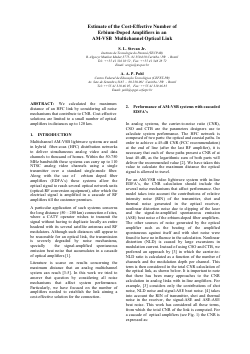
Estimate of the Cost-Effective Number of Erbium-Doped Amplifiers in an AM-VSB Multichannel Optical Link
S. L. Stevan Jr., A. A. P. Pohl
DOI: 10.14209/its.2002.794
Keywords:
Abstract
"We calculated the maximum distance of an HFC link by considering all noise mechanisms that contribute to CNR. Cost-effective solutions are limited to a small number of optical amplifiers in distances up to 120 km."Download
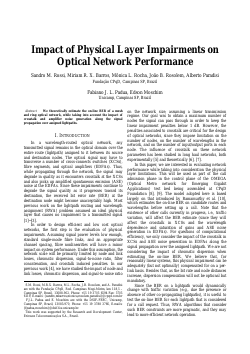
Impact of physical layer impairments on optical network performance
Sandro M. Rossi, Miriam R. X. Barros, Mônica L. Rocha, João B. Rosolem, Alberto Paradisi, Fabiano J. L. Padua, Edson Moschim
DOI: 10.14209/its.2002.797
Keywords:
Abstract
"We theoretically estimate the on-line BER of a mesh and ring optical network, while taking into account the impact of crosstalk and amplifier noise generation along the signal propagation over assigned lightpaths."Download

Signal Gain and Degradation in Fiber Raman Amplifiers
Shirley P. Neves, Marcio Freitas, Luiz C. Calmon
DOI: 10.14209/its.2002.802
Keywords:
Abstract
"Raman Fiber Amplifiers will be important for the next generation high speed dense WDM optical communications systems due to its inherent broadband characteristics, fast response, moderate gain, and low noise figure. Signal gain characteristics of Raman amplifiers have been investigated recently, but very little has been said about signal degradation caused by dispersion and nonlinear effects in Raman amplifiers. This paper analyses different types of fibers as candidates for Fiber Raman Amplifiers considering signal gain issues, but also takes into account dynamic aspects related to signal degradation caused by group velocity dispersion and diverse nonlinear effects such as self-phase and cross-phase modulations."Download

Experiment and Simulation on the Reduction of the Semiconductor Optical Amplifier Optoelectronic Switching Time
Cristiano M. Gallep, Evandro Conforti
DOI: 10.14209/its.2002.807
Keywords: semiconductor optical amplifier optical switching pre-pulse current injection
Abstract
"A technique to reduce the Semiconductor Optical Amplifier electro-optic switching times is implement. The technique, called PISIC (pre-impulse-step injected current), presented a reduction of the SOA switching times from almost 2ns (simple-step current response) to little more than 200ps (step with pre-pulse response). Forecasts done through simulations, using optimized values of current step and pre-pulse, showed even a faster optical switch response, with switching time reduction to values around 10 ps."Download
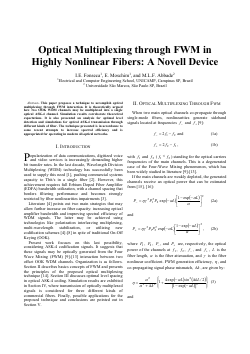
Optical Multiplexing through FWM in Highly Nonlinear Fibers: A Novell Device
I.E. Fonseca, E. Moschim, M.L.F. Abbade
DOI: 10.14209/its.2002.811
Keywords:
Abstract
"This paper proposes a technique to accomplish optical multiplexing through FWM interaction. It is theoretically argued how two OOK WDM channels may be multiplexed into a single optical ASK-4 channel. Simulation results corroborate theoretical expectations. It is also presented an analysis for optimal level detection and simulations for optical ASK-4 transmission through different kinds of fiber. The technique presented is in accordance to some recent attempts to increase spectral efficiency and is appropriated for operating in modern all-optical networks."Download